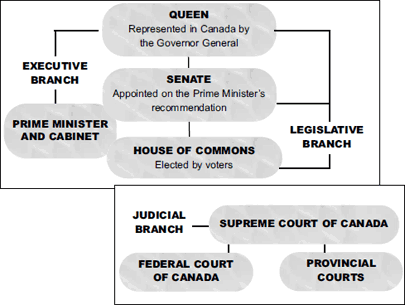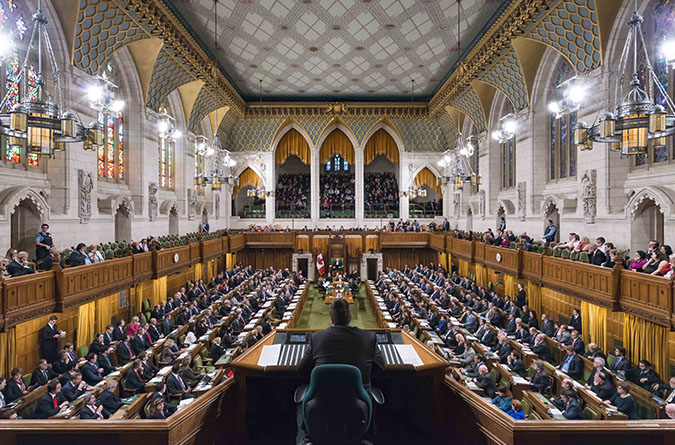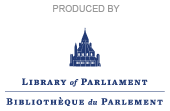Guide to the Canadian House of Commons
The Canadian Parliament

Photo: Library of Parliament / Roy Grogan
Our system of government is part of the reason why Canada is known around the world as a good place to live. Canada's parliamentary system is open and democratic. It offers the opportunity for people to give their input and it is designed to make sure proposals for laws are carefully considered.
Canada's Parliament consists of three parts: the Queen, the Senate and the House of Commons. They work together to make the laws for our country. The executive branch consists of the Queen, the Prime Minister and Cabinet, and the departments of government. They implement the laws. The legislative branch makes the laws, and the judicial branch — which is not part of Parliament — interprets them.
Canada’s Parliamentary System

The Queen
Canada is a constitutional monarchy. This means that the laws governing Canada recognize the Queen as the formal Head of State. All federal laws are made in the Queen's name. She also performs many important ceremonial duties when visiting Canada.
The Governor General

The Governor General's Standard is a symbol of the Crown's sovereignty in Canada.
The Governor General is the Queen's representative in Canada. The Queen appoints the Governor General on the advice of the Prime Minister. The Governor General usually serves for five years. One of the most important roles of the Governor General is to ensure that Canada always has a Prime Minister. For example, if no party had a clear majority after an election, or if the Prime Minister were to die in office, the Governor General would have to choose a successor.
The Governor General acts on the advice of the Prime Minister and Cabinet. The duties of the Governor General include: summoning, opening and ending sessions of Parliament; reading the Speech from the Throne; giving Royal Assent to bills; signing state documents; and dissolving Parliament for an election.
The Senate
| Distribution of Senate Seats |
|||
|---|---|---|---|
| Area | Seats | ||
| Ontario | 24 | ||
| Quebec | 24 | ||
| Maritimes | 24 | ||
| Nova Scotia | 10 | ||
| New Brunswick | 10 | ||
| Prince Edward Island | 4 | ||
| Western Provinces | 24 | ||
| Manitoba | 6 | ||
| British Columbia | 6 | ||
| Saskatchewan | 6 | ||
| Alberta | 6 | ||
| Additional representation | 9 | ||
| Newfoundland and Labrador | 6 | ||
| Northwest Territories | 1 | ||
| Yukon | 1 | ||
| Nunavut | 1 | ||
| Total | 105 | ||
The Senate studies, amends and either rejects or approves bills passed by the House of Commons. It can also introduce its own bills, except those to spend public money or impose taxes, which must be introduced in the House of Commons. No bill can become law until it has been passed by the Senate. Senators also study major social, legal and economic issues through their committee work.
One of the duties of the Senate is to represent the interests of Canada's regions, provinces, territories and minority groups. Seats in the Senate are distributed to give each major region of the country equal representation.
The Senate has 105 members. Senators are appointed by the Governor General on the recommendation of the Prime Minister and hold office until age 75.
The House of Commons
| Distribution of House of Commons Seats |
|
|---|---|
| Area | Seats |
| Ontario | 121 |
| Quebec | 78 |
| Nova Scotia | 11 |
| New Brunswick | 10 |
| Manitoba | 14 |
| British Columbia | 42 |
| Prince Edward Island | 4 |
| Saskatchewan | 14 |
| Alberta | 34 |
| Newfoundland and Labrador | 7 |
| Northwest Territories | 1 |
| Yukon | 1 |
| Nunavut | 1 |
| Total | 338 |
Many laws in Canada first begin as bills in the House of Commons. In the Commons Chamber, Members devote most of their time to debating and voting on bills. The Chamber is also a place where Members represent constituents' views, discuss national issues and call on the government to explain its actions.
To become a Member of Parliament, you must first run in a federal election, which is held every four years. In each of the country's 338 constituencies, or ridings, the candidate who gets the most votes is elected to the House of Commons, even if he or she gets less than half of the total votes.
Seats in the House of Commons are distributed roughly in proportion to the population of each province and territory. In general, the more people in a province or territory, the more Members it has in the House of Commons. Every province or territory must have at least as many Members in the Commons as it has in the Senate.

Photo: Library of Parliament / Martin Lipman

